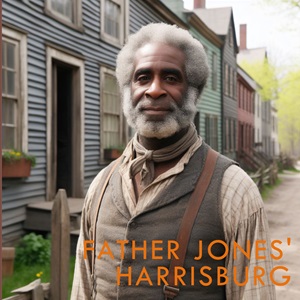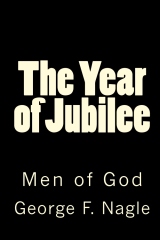

Study Areas
Obituary of Dr. William M. Jones, 1881
Dr. William M. Jones died at his residence, 422 South street, on Monday afternoon. He was born at Kingston, Luzerne county, 1791, and was consequently in this ninety-first year at his death. He came to this borough in 1822, on an ark, with his wife and two children, from Wilkes-barre. The ark was loaded with twelve tons of coal and his furniture. He disposed of the coal, after some trouble, to Samuel Bigler, who kept a tavern at the corner of Front and Chestnut streets, on the site of which Mr. Dull is now putting up a residence. Mr. Bigler paid twelve dollars for the twelve tons. After locating his family, Mr. Jones began work for Mr. Calender, a druggist, with whom he remained for four years. Dr. D. W. Gross, having purchased Calender's interest, he conducted the business, with whom Jones remained for some years, and where he received the title of "Dr.," having acquired some knowledge of the compounding of medicines. He left Dr. Gross to go into a foundry as a laborer, where in time he became a molder, working at that trade for very many years up to 1840.
He became much interested in the Peruvian system of medicine, which he practiced, in connection with his son Henry, from 1843 up to the time of his death. He traveled as a practising physician in Schuylkill, Lebanon, Lancaster, York, Cumberland and Dauphin counties. In the meantime he gave his attention to the blowing in of anthracite furnaces, in which he was regarded as an expert and reliable.
Dr. Jones was the father of twelve children, five sons and seven daughters, ten of whom survive him. He had eleven grand children, eight of whom survive him, and two great grandchildren. He was a man of liberal and charitable dealing, the friend and advisor of men and women of his own race.
In his early days he took a large interest in the fugitive slave, having been the head of an organization to aid them in their escape from the South to Canada. He took formal charge of all such fugitives, and carried them hundreds of them safely to Canada. He was a resolute man, and with the assistance of his devoted supporter and friend, the late Joseph Pople, he struck the shackles from many a bondsman's limbs and made him free. Dr. Jones also was a preacher in his day, and one of the first to organize Wesley African Methodist Episcopal church, then on Third street, now located on South. He also organized societies for benevolent purposes in connection with his race, and was a member of the church he organized for fifty-nine years. As a citizen, he had the respect of all good men, and lived an upright life.
Notes
The druggist with whom William Jones worked the longest, Dr. D.W. Gross, is Daniel Wiestling Gross (1810-1896), a druggist and apothecary whose shop beginning in 1830 was on Market Street. More research is needed on the identity of the first druggist, Mr. Calender. (Egle, Notes and Queries).
The "Peruvian system of medicine" refers to Jones' interest and strong belief in herbal remedies and cures. In particular, it refers to those herbs, barks, powders and tinctures that originated in Spanish America around the Amazon and which had become more easily obtainable in the Northamerican colonies in the half-century just before his birth. The name may have derived from the botanicals Peruvian Bark and Peruvian Balsam, both important in the treatment of ailments. Herbal medicines represented a natural approach to treating sickness that was less harsh than the purgatives, bloodletting, emetics, camphor and mercury therapies that were still used.
William Jones embraced not only new medicines, but as the obituary notes, he was also "regarded as an expert" on the new anthracite iron-making technology. By the early 1800s, local iron furnaces were finding that the extensive acres of timbered land for charcoal production were increasingly scarce. Abundant anthracite was found to be a poor substitute for charcoal when used in cold blast iron production. But a furnace redesigned for hot blast production could utilize the anthracite that was becoming increasingly available from Schuyllkill County mines. Pottsville, one of the locations frequented by Jones on his travels, was one of the first Pennsylvania towns to be successful with hot blast furnaces burning anthracite. Exactly how Jones interacted with local forge masters is not known at this time, but his work experience at forges, combined with his familiarity with and frequent travels through the anthracite regions and iron making regions of central Pennsylvania deserves more attention.
Sources
Harrisburg Telegraph, 3 August 1881.
On Peruvian medicine, see "World Trade in Medicinal Plants from Spanish America, 1717–1815," by Stefanie Ganger, Medical History, 59(1) January 2015. at https://www.ncbi.nlm.nih.gov/pmc/articles/PMC4304538/
On "blowing in" an iron furnace, see "How to 'Blow In' a Newly Built or Cold Iron Furnace," by Gerald Eggert, Building Community: Medieval Technology and American History, Penn State University, at https://www.engr.psu.edu/mtah/essays/howto_blowin.htm
For a good discussion of the changeover from charcoal to anthracite in iron production, see "Anthracite Iron Blast Furnaces in Lancaster County 1840-1900," by John Ward Willson Loose, Lancaster County Historical Society, https://collections.lancasterhistory.org/media/library/docs/edit_vol86no3pp78_117.pdf
The Year of Jubilee
Vol. 1: Men of God and Vol. 2: Men of Muscle
by George Nagle


Both volumes of the Afrolumens book are now available on this site to read for free.

